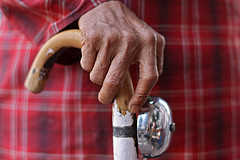 Ask any doctor, physical therapist, orthopedic surgeon or any medical professional for that matter, and they will tell you: choosing the right cane handle is an exceedingly important decision. There are many popular options that have existed for a long period of time, and there are several newer designs that have come along with growing research into human anatomy. At the end of this article, you should be better prepared to speak to your medical professional about which cane handle type is right for you.
Ask any doctor, physical therapist, orthopedic surgeon or any medical professional for that matter, and they will tell you: choosing the right cane handle is an exceedingly important decision. There are many popular options that have existed for a long period of time, and there are several newer designs that have come along with growing research into human anatomy. At the end of this article, you should be better prepared to speak to your medical professional about which cane handle type is right for you.
Tourist-Handle Canes
First, the age-old favorite, a popular design from the times of the fertile crescent and made even more recognizable in its usage in religious imagery from throughout history, is the tourist cane. Also referred to as a j-shaped handle, a shepherd’s crook cane, or a traditional crook cane, this design is almost as old as any style you can still find on the market today. It is usually constructed using a single piece of wood, soaked, bent and treated through a process that provides strength, shock absorption and the sturdiness of solid wood.
The curve in the handle provides a certain level of convenience and comfort. Not only does it provide a wide area for you to find the most comfortable position with which to hold and use your cane, but it also make it easy to hang over your elbow, on the edge of a table, doorknob or even in a closet when not in use.
Obvious, a design this old would not have lasted so long were it not such a popular choice among cane users.
Knob-Handle Canes
Along with the tourist, one of the oldest styles is the knob-handle cane. This simple design puts a small ball or knob, only slightly wider than the shaft of the cane, directly above the shaft. There are several types of knobs, although some of the more decorative ones, while beautiful, are a but more impractical to use as a mobility aid. Several are designed to fit into the palm of your hand, or offer a symmetrical design so it becomes easier to manipulate. Again, this ancient design has lasted through the centuries because of its popularity among users. Of course, it may not be right for you, especially If arthritis or another condition makes it difficult for you to grasp the handle of your cane.
That being said, the design allows all of the weight of a person to be evenly distributed along the shaft of the cane, since the handle sits right atop the center of the shaft. This makes for a very rigid, very stable design, which has been known to outlast other handle-types.
Derby-Handle Canes
When compared to the tourist or knob handles, the derby-handle design might seem to be a modern innovation, but in reality, it has been around at least since the 1400’s. Like the knob handle, this piece is designed to place the majority of the wight of a user over the shaft of the cane. It has a small hook in the end, providing some of the convenience of a tourist. It is also cut so that the palm of the hand fits over it in a certain way, so in some cases, users have complained about “cramped fingers.” However, generally this is one of the favorites, and it can be seen in use all over the world. Also, this cane doesn’t need to be made out of a single piece of material, which makes matching a handle to a cane shaft a much easier process.
Fritz-Handle Canes
A modification of the derby handle, the fritz-style handle also makes room for the thumb to wrap around the intersection of the handle and shaft for a steady grip, but doesn’t include the added hook at the end of the handle, removing the “cramped fingers” phenomenon. This easy to grasp handle is perfect for people who suffer from arthritis but would like a piece with the classic style of an older design.
Ergonomically-Designed Handles
Both the derby and the fritz handles have been modified even further as technology and medical practice have allowed us to know more about how people use canes and experiment with handle designs to find the balance of comfort and support everyone is looking for. In these cases, the designs have been built with grooves or modifications which make the piece conform to the natural grooves in the palm of your hand. They are highly recommended for some medical needs because of the ease of grasping and the physics of designing a cane which evenly distributes weight and shock.
Palm-Grip Handles
Possibly the most impressive design is the palm-grip handle. In this design, the cane handle is not a crossbar like most designs, but rather a more flat surface where the hell of the palm can distribute the shock and weight beyond the wrist and into your arm instead. This is an exceedingly comfortable cane, but the high-tech design is only usable for either the right or left hand, so the user has to be very careful when placing the order, and very conscious of the fact that it will be of little-to-no use in the opposite hand.
Offset Handles
With the onset of aluminum and carbon-fiber construction materials, and the inception of inexpensive polyurethane and other materials, the foam handle has become popular. Easy to grasp and open-ended like the fritz handle, this offset design is very affordable, and oftentimes a very comfortable option. It is one of the most popular designs for quad-canes, and easy to find at just about any retailer.
Mia works for Fashionable Canes, a manufacturer and retailer of walking sticks and canes made for fashion, travel and health purposes.



Leave a Reply